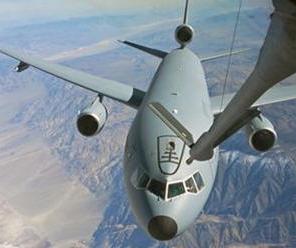 |
|
|
|
|
|
|
|
|
"The Block 45 modification was needed to extend the
KC-135 aircraft as a viable weapon system through fiscal
year 2040," added Mikal. "The Block 45 systems mitigate
capability gaps and improve overall KC-135 shortcomings
in reliability, maintainability and supportability."
At
the initial start of the KC-135 Block 45 program, it was
originally estimated that testing would end in March
2011, but the technical challenge of integrating the new
digital systems proved to be very challenging, according
to the test team.
"It took an amazing amount of ingenuity and hard work by
the collective KC-135 Block 45 upgrade team, due to the
program experiencing a two-month stop in test in early
2012 to determine the cause of a structural coupling
event which occurred during flight test," Mikal said.
"While clearing the aerial refueling envelope, the
performance of the new autopilot altitude hold was so
good, re-adjustment was required to improve stability
during aerial refueling coupled flight."
Along with the 418th, the massive, multi-year
undertaking required support from more than 90 members
to overcome technical hurdles and prevent the very real
threat of program cancellation. Of those included,
individuals were acquired from the 412th Test Wing,
412th Operations Group, 412th Test and Engineering
Group, 773rd Test Squadron, 775th Test Squadron, 370th
Flight Test Squadron, 445th Flight Test Squadron, the
KC-135 Special Programs Office, Rockwell Collins, Air
Mobility Command Test and Evaluation Squadron Detachment
3, AMC Air, Space and Information Operations (A3), and
McConnell Air Force Base, Kan.
"There were only two KC-135 aircrew in the 418th FLTS
when the program started. Eventually, the 418th FLTS
KC-135 aircrew numbered four; even so, Test Operations
was largely instrumental in supporting the program with
their KC-135 aircrew," said Mikal.
Most notably though was the Edwards team, which was able
to complete the final testing $200,000 below cost and
three weeks ahead of new schedule through extremely
efficient testing and test execution flexibility despite
regular scope changes, priority changes, funding
rebaseline, weather cancellations, maintenance issues,
resource rescheduling/constraints, and the ultimate
challenge of addressing the AR oscillation issue with no
additional schedule or funding impacts.
"In the end, the Global Reach Combined Test Force test
team proved to be a pivotal contributor, bringing this
challenged program to a successful completion," added
Mikal. "Successful completion of this program has
secured the opportunity to field Block 45 to the KC-135
fleet, while preventing the otherwise inevitable
reduction in overall mission effectiveness due to
avionics obsolescence and CNS/ATM airspace access
issues. Without the KC-135 Block 45, 88-percent of the
USAF tanker assets would eventually be unable to
complete their mission." It is currently estimated that the first 179 KC-46 aircraft will be delivered by 2028. |
||||
|
|
||||


